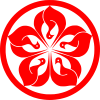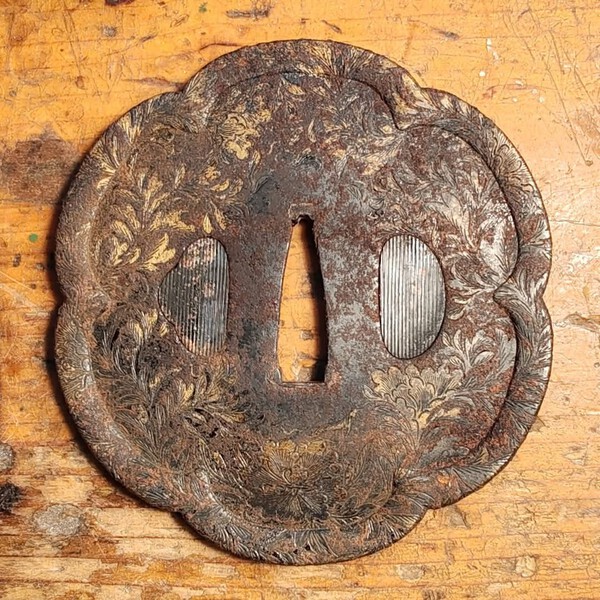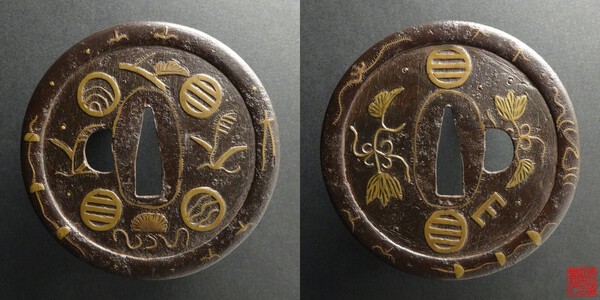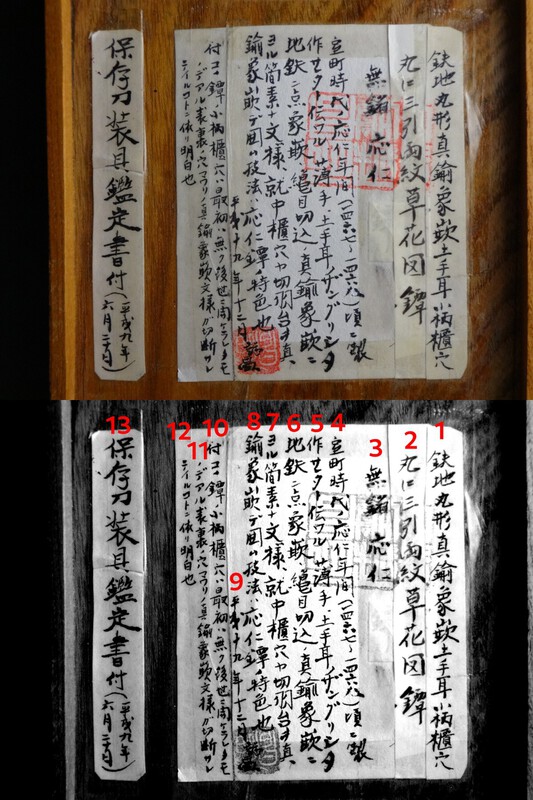-
Posts
496 -
Joined
-
Last visited
-
Days Won
5
Content Type
Profiles
Forums
Events
Store
Downloads
Gallery
Everything posted by zanilu
-
In martial arts different school have given different answers to the same problems. In most cases what is the solution of one is anathefor another! In Katayama Ryu and Katory Shinto Ryu the the tsuba is a protection to the hand for example. Regards Luca
-
You are right Mauro! My mistake! Bravo!
-
I agree with John. The first one is definetly Kaga zogan. The base plate looks like iron, this will place it to the early production of the school. The later production is mainly with a shakudo plate. You can find more information here: I hope it helps. Regards Luca
-
There is an old saying in Italy that goes: Non c'é peggior sordo di chi non vuol sentire (There is none so deaf as he who will not hear).
-
Much ado about nothing!
-

A word about amateur polishing
zanilu replied to Brian's topic in General Nihonto Related Discussion
@Dan tsuba if you judge the quality of a post by the number of views you better go on TikTok... The value and quality of a post is not measured in that way here! Luca -
Please do not judge the forum just for the childish behavior of one person. He do not represent our community! Not at all! Luca
-
Also similar to mine: Tsuba with design of peonies and arabesques Washida Mitsunaka (Japanese, 1830–1889) School: Shonai School (Japanese)JapaneseEdo period1847 Medium/Technique Main material: iron; other metals: silver; shakudo plugs; decorative technique: hirazogan Dimensions Overall: 8.4 x 8.1 x 0.3 cm (3 5/16 x 3 3/16 x 1/8 in.) William Sturgis Bigelow Collection Accession Number 11.12197 Signed Shonai no ju Washida Mitsunaka, with a kao; Koka yon hinoto-hitsuji natsu juhassai saku 庄内住鷲田光中(花押)弘化四丁未夏十八歳作 Provenance By 1911, purchased by William Sturgis Bigelow (b. 1850 - d. 1926), Boston [see note 1]; 1911, gift of Bigelow to the MFA. (Accession Date: August 3, 1911) NOTES: [1] Much of Bigelow's collection of Asian art was formed during his residence in Japan between 1882 and 1889, although he also made acquisitions in Europe and the United States. Bigelow deposited many of these objects at the MFA in 1890 before donating them to the Museum's collection at later dates. https://collections.mfa.org/objects/11916
-
Superb job, Manuel. This piece has come back to life straight from the junk box. Washida Mitsunaka has produced several tsuba of this kind like https://www.metmuseu...lection/search/23060
-
Greetings to All, Recently, I acquired a rather rusty tsuba as part of a deal for a Washida tsuba with another collector. This piece was thrown into the arrangement by the seller to meet the requested price range. Despite its condition, it showed some promise. The tsuba is signed Kyozan Mitsunaka + (Kao) ({嚮山 光中(花押)}) in kin-zogan. Based on the pictures, it appeared to feature brass hira-zogan of peonies and arabesques. Despite the rust, none of the inlays seemed to be missing - testament to the craftsmanship. The subject and execution also align well with works by Washida Mitsunaka or the Washida school. Seeing its potential, I decided to accept the deal, and both tsuba landed on my desk. Believing the piece was worth restoring, I sent it to Manuel @C0D for restoration, and I wasn't disappointed. Manuel did an outstanding job removing the rust and re-patinating the brass. If Manuel would like to elaborate on the restoration process, I would welcome it. The gamble paid off, as the final result is quite pleasing. As you can see, the tsuba has been brought back to life: I hope you enjoy it as much as I do. Regards, Luca P.S. I have to thank Manuel for allowing me to use the pictures he made.
- 8 replies
-
- 28
-

-

-

-
Nice buy, not bad at all. Only the gold iroe on the fuchi dragon looks odd, but could be light shining on it! Regards Luca
-
Non ragioniam di lor, ma guarda e passa... Do not worry Dee
-
I personally stick to the principle of having a fewer number of good quality pieces compared to a large number of low quality ones. Unless you handle good pieces it is very difficult to develop a real feel for quality. On this forum you will find a good deal of them and experienced people willing to guide you in the process. Be prepared to make mistakes, I did as my junkbox box reminds me too often... Regards Luca
-
Thank you both Dave and Steve I am not using AI as much as I should! You can not teach new tricks to an old dog... Or at least it takes a while Regards Luca
-
Thak you Steve I was trusting google for the translation of the kanji from the NBTHK paper! A mistake it seems... Regards Luca
-
Dear All In a NBTHK paper describing a Washida tsuba I have found the following term: 鋤下彫 that should read something like sukishita-bori or sughishita-bori and should be a sort of sunken carving. Do you have a better description or examples of this technique? Than you in advance for your help. Regards Luca
-
Sorry Dale! My mistake! Luca
-
Multiple layers tsuba as Akasaka tsuba,with two layers of better iron on the outside and and lower grade one in the middle were obtained by forging. Far better and easier way of obtaining a layered structure. What you suggest Dale is almost impossible. Molten iron flows like water and do not stick on other iron... What I see in the pictures you posted could be the effect of delamination of a forged and folded tsuba. No need to invent an involved process... Regards Luca
-

Eric Molinier/ericowazamono Shill bidding?
zanilu replied to Tensho's topic in Auctions and Online Sales or Sellers
I had a couple of deals with Eric directly through Facebook and I can only speak well of him. The items were exactly as described, the communication excellent and to the point, shipping fast... No complains from my side. Luca -
I think thst something in the line of what is done in scientific publications with papers reviewed by peers is the right approach Steve! And on this forum we have a lot of people that has the knowledge and the skills to be a rewier. I am, in a very small way, trying to do that on arguments and schools that spark my interest and are represented in my collection. Luca
-

Help with Translation and Meaning of an Onin Tsuba Hakogaki
zanilu replied to zanilu's topic in Translation Assistance
Tahk you both, Moriyama san and John san! You are wonderful! I love this community. Regards Luca -
Dear All I am seeking your help for the interpretation of the kanji in this "Hakogaki". It is attached inside the lid of this Onin tsuba: I have tried to decipher as much kanji as possible but I am a little bit out of my league with written Japanese. I can manage most of the printed one, mainly thanks to various tools, but here I struggle. This is what I got so far: 1: 鉄地丸形真[鍮]象嵌上手耳小柄櫃[孔] 2: 丸に三引両紋草花図鐔 3: 無銘 応仁 4: [室]町時[代]応仁[年][间] (一四[?][?]一四[?][?]) [頃][?][?] 5: [作][々][夕][ト][伝][ワ][ル][手]土手耳[?][グ][リ][シ][タ] 6: [地][鉄][?][象][?][?][目][?][込]真鍮象嵌[?] 7: [ヨ][ル][筒][?][?][文][様][就][中][?][穴][ヤ][切][羽][台][?][真]\ 8: [鍮]象嵌[?][囲][?][法][?][応][仁][鐔][特][色]也 9: [?][?]十九年十二月[嘉][辰] 10: 付コ[?]鐔.小柄櫃穴‥[日]取初‥[無][ク][後][せ][=][?][ケ][ラ][し][モ] 11: [?]デアル[?][?].穴コワリ[?]真鍮象嵌文様ガ切[?]クレ 12: テイルコト二休リ明白也 13: 保存刀装具鑑定書付 (六平月成二九十年日) I put uncertain charter between "[]", the completely unknown are replaced by "[?]". Any help is appreciated. I know I am asking a lot, if you can help me but think that the effort shall be rewarded please pm me. All the best Luca
-
Grev exactly for this reason my collection catalog will most probably will never be printed in physical form. Only pdf... Similarities with Soten were my first impression too. Looking into it tough Goto pieces with warriors look more alike. My reasoning is explained with examples in the pdf. I really hope you enjoy it. Regards Luca
-
Thank you Paul. Yes indeed it is part of the Appendices volume to my collection catalogs that by now amount to more than 900 pages, two volumes for the pieces plus one for appendices. Regards Luca













